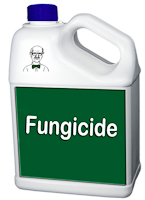|
 |
|
 |
|
 |
|
 |
 |
 Ever
go out in the spring as soon as the snow melts off to
find a whitish, webby appearance to your lawn? Well, the
most likely culprit is a fungal disease called
appropriately, snow mold. Ever
go out in the spring as soon as the snow melts off to
find a whitish, webby appearance to your lawn? Well, the
most likely culprit is a fungal disease called
appropriately, snow mold.
Also as the name implies,
this turfgrass disease, oddly enough, is encouraged by
having the lawn covered by snow for long periods over
the winter. The snow holds the moisture and, to a
certain extent, warmer temperatures against the grass.
This particular fungus can grow at low temperatures and
thrives under these conditions. Thus, snow mold will not
show up after a winter with light snowfall.
Fortunately, most
instances of snow mold are not a serious threat to the
lawn. Usually, all you need to do is rake away the moldy
grass and it will recover nicely. If your lawn is in
poor condition, under-fertilized, thin and, perhaps, has
compacted soils, some grass may die from a heavy
infestation of snow mold,
|
 |
 |
 |
As with most fungal
diseases, moisture is the key to this disease. The
longer the plant leaves are wet, the higher the
possibility of developing this disease. So, one way
of helping to prevent or minimize this problem is to
help the grass to dry more quickly. An often
recommended cultural technique is to be sure to mow
the grass a little shorter during the final mowing
of the year. Of course, it is always tough to
determine exactly when that last mowing will be but
it is good to drop the mowing height that one time
of the year before the snow flies.
|
 |
 |
 |
 Normally, when dealing
with fungal diseases of plants, the object is to apply a
fungicide as a preventative. However, this disease is a
tough one to try to treat in that manner. Once you
discover the symptoms of the disease, it is already too
late to treat. So, fungicides are generally not
recommended. Normally, when dealing
with fungal diseases of plants, the object is to apply a
fungicide as a preventative. However, this disease is a
tough one to try to treat in that manner. Once you
discover the symptoms of the disease, it is already too
late to treat. So, fungicides are generally not
recommended. So, the best
approach is to just keep on doing those things that
normally keep a lawn nice and healthy i.e. proper
fertilization, thatch control, irrigation, mowing
height, etc. An otherwise healthy lawn should pull
through an attack of snow mold just fine. Simply rake
away the gray colored stuff from the green grass.
|
|
 |
|
Note: We
have provided some general information and
observations on this topic aimed at the home
gardener. Before you take
any serious action in your landscape, check
with your state's land grant university's
Cooperative
Extension
Service for the most current,
appropriate, localized recommendations. |
|
 |
|



